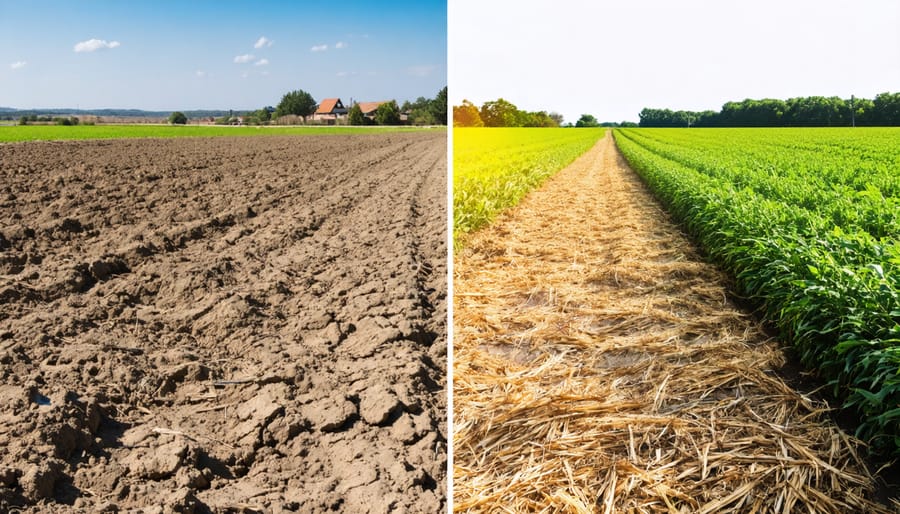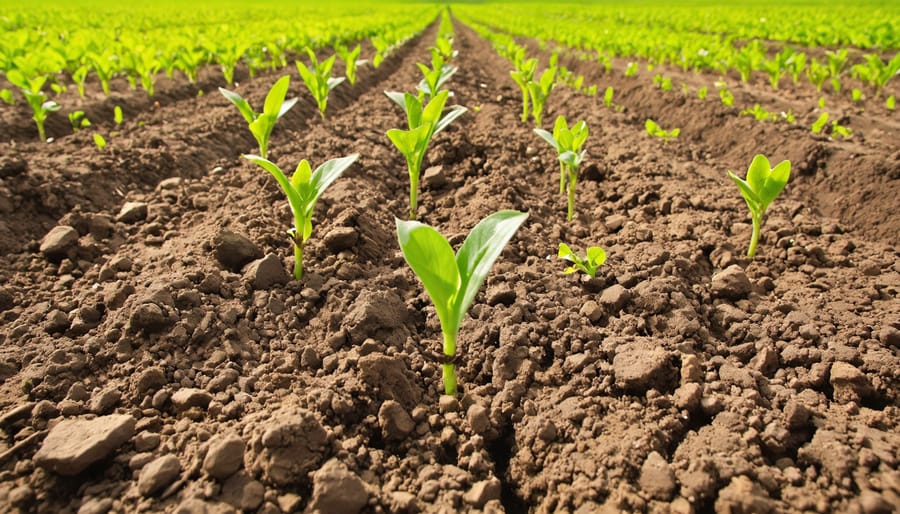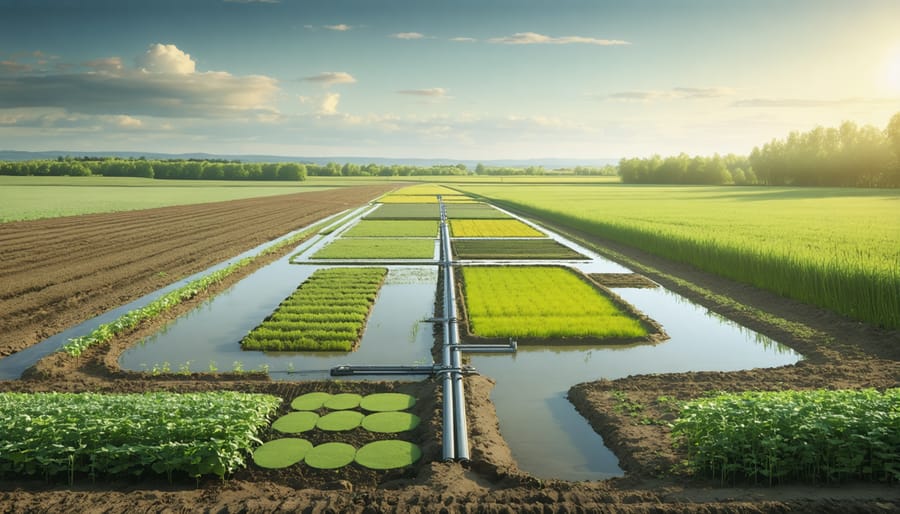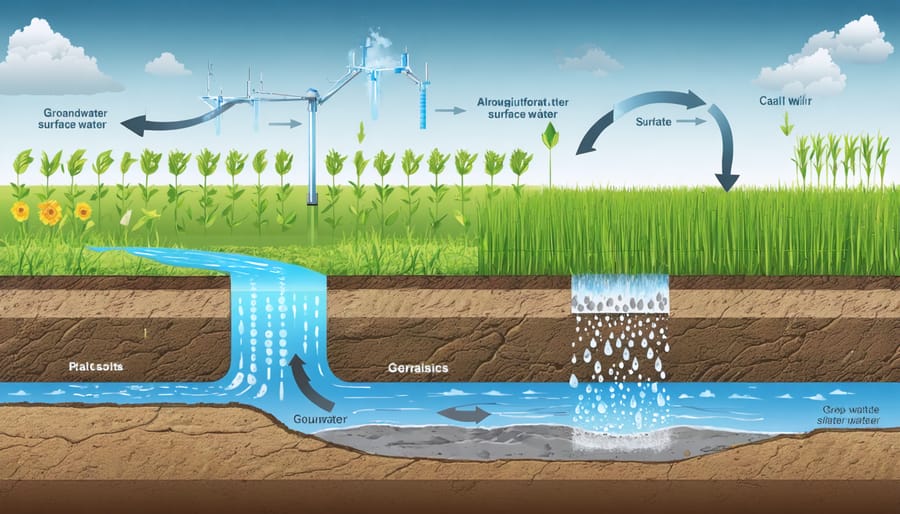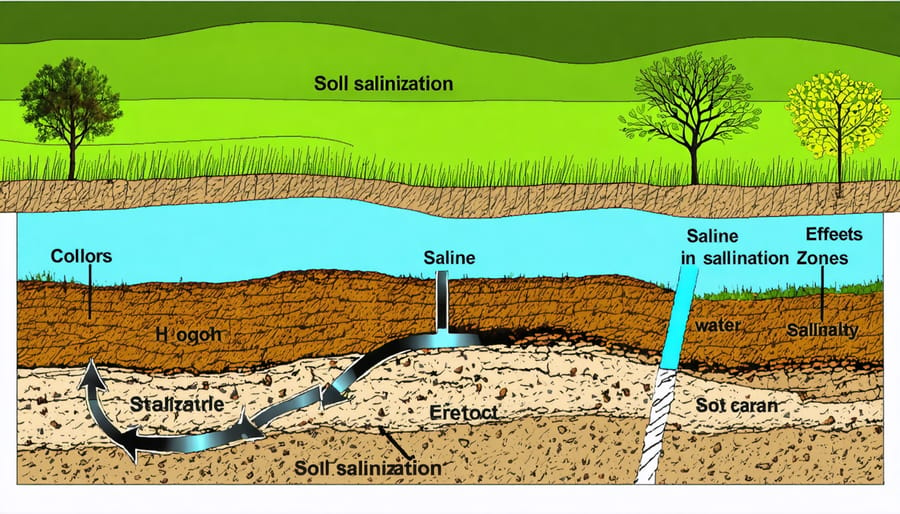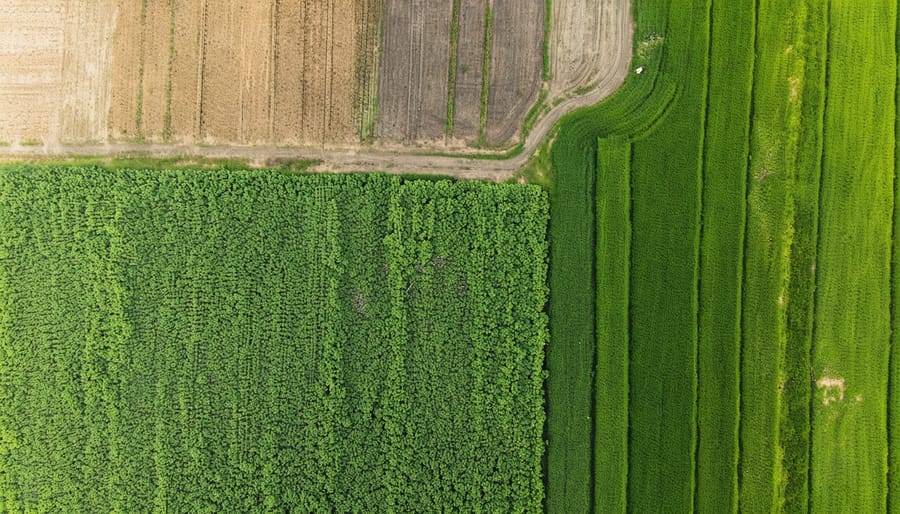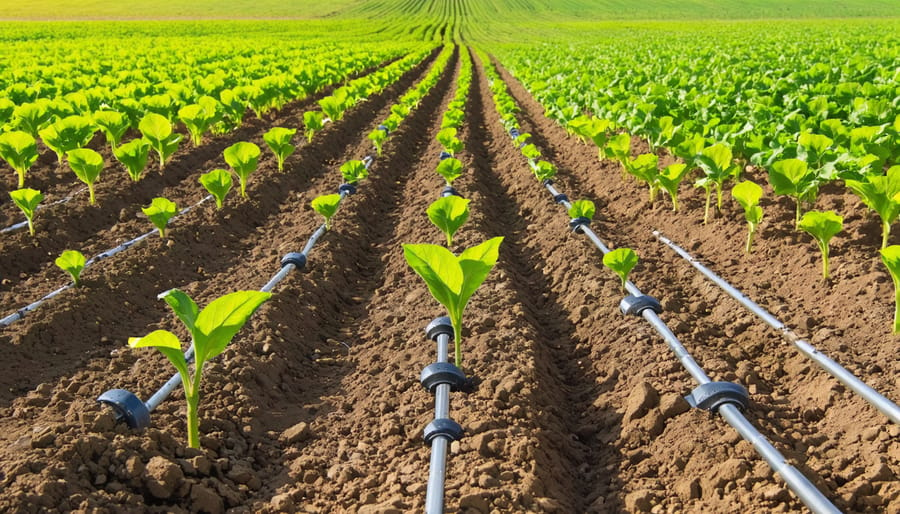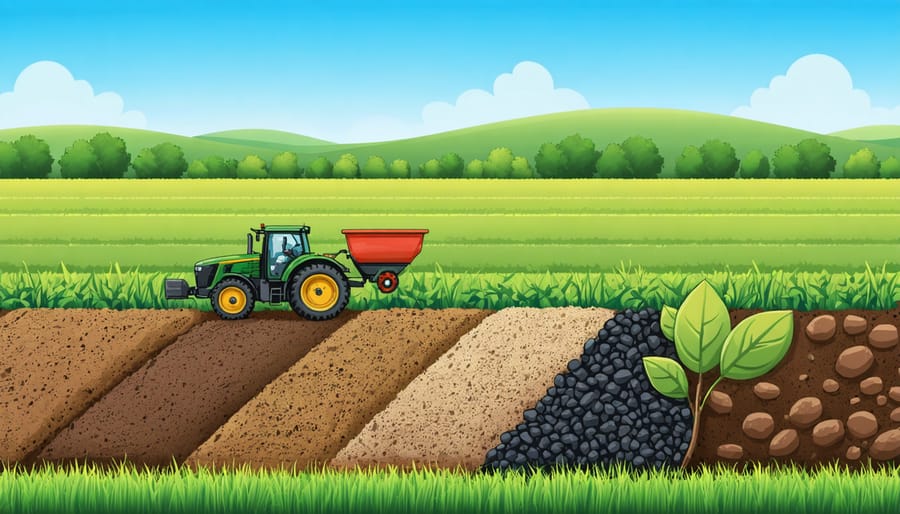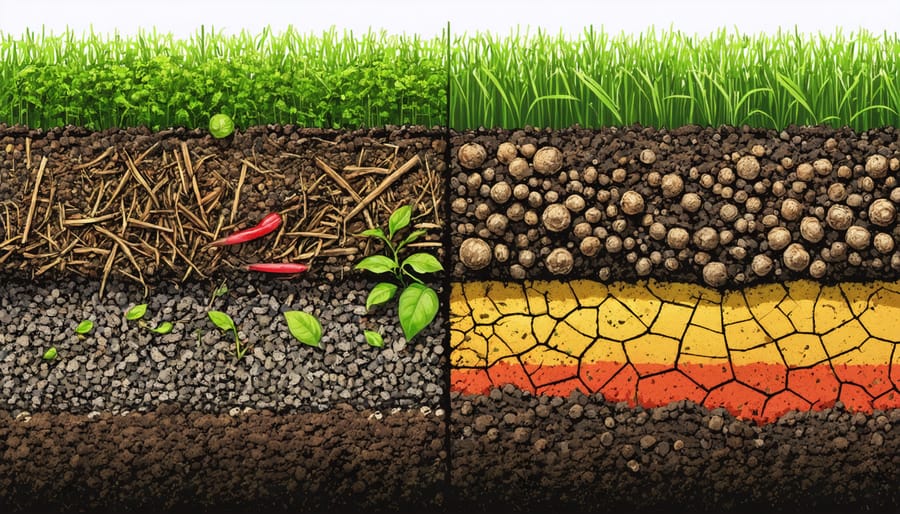Deploy shredded straw mulch in 10-15 centimetre layers across vulnerable slopes to immediately reduce soil loss by up to 80% during heavy rainfall. Integrate living ground covers like clover between crop rows, combining soil health preservation with enhanced erosion control. Install engineered wood chip barriers at field edges and waterways, creating natural sediment traps that protect valuable topsoil while enriching organic matter content.
Alberta’s challenging climate demands robust erosion control strategies, and mulching stands out as one of the most cost-effective solutions. By protecting 85% of exposed soil surface, properly applied mulch significantly reduces the impact of wind and water erosion while conserving crucial moisture levels. Local research demonstrates that farms implementing strategic mulching techniques experience 60% less soil displacement during spring thaws and summer storms, safeguarding both immediate crop yields and long-term land productivity.
Why Alberta Farms Need Mulch-Based Erosion Control
The Real Cost of Soil Erosion
In Alberta, soil erosion costs farmers an estimated $257 million annually through reduced crop yields and increased input costs. Recent studies from Agriculture Alberta show that our province loses approximately 68 million tonnes of topsoil yearly – enough to fill 45,000 Olympic-sized swimming pools. This loss directly impacts farm productivity, with affected fields showing yield reductions of 15-25% compared to protected areas.
Beyond the immediate financial impact, soil degradation affects long-term land value and sustainability. Fields with significant erosion typically require 20-40% more fertilizer and water to maintain productivity, creating a cycle of increasing operational costs. Implementation of effective soil and water conservation practices can reduce these losses by up to 80%, offering a return on investment within 2-3 growing seasons.
The hidden costs extend to our water systems, with eroded soil contributing to decreased water quality and increased treatment costs for local communities. By addressing erosion through proper mulching techniques, farmers can protect both their bottom line and our shared natural resources.
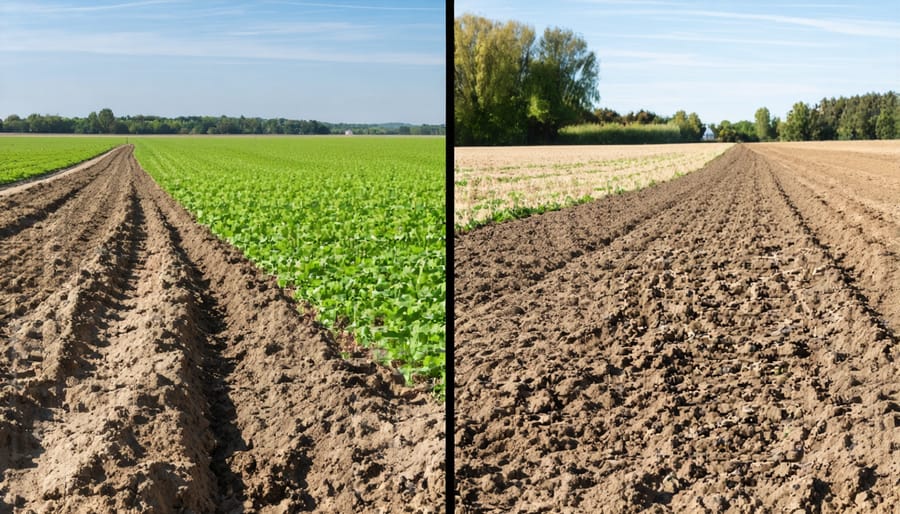
How Mulch Fights Back
Mulch works as a natural shield against erosion through multiple mechanisms that protect your valuable topsoil. When rain hits a mulch layer, it breaks up the water’s impact force, preventing soil particles from becoming dislodged and washed away. Think of mulch as your soil’s suit of armour, absorbing the blow of each raindrop.
The physical presence of mulch creates a maze-like network that slows water flow across your fields. This reduced velocity gives water more time to seep into the soil rather than running off and taking precious topsoil with it. During our prairie windstorms, mulch acts as a windbreak at ground level, keeping soil particles in place when gusts pick up.
But mulch doesn’t just defend – it builds. As organic mulches break down, they improve soil structure by adding organic matter and encouraging beneficial microorganism activity. This enhanced soil structure creates better water infiltration and stronger soil aggregates that resist erosion naturally. Many Alberta farmers have found that maintaining a 5-10 cm layer of mulch provides optimal protection while allowing for proper soil warming in our shorter growing season.
Choosing the Right Mulch Materials
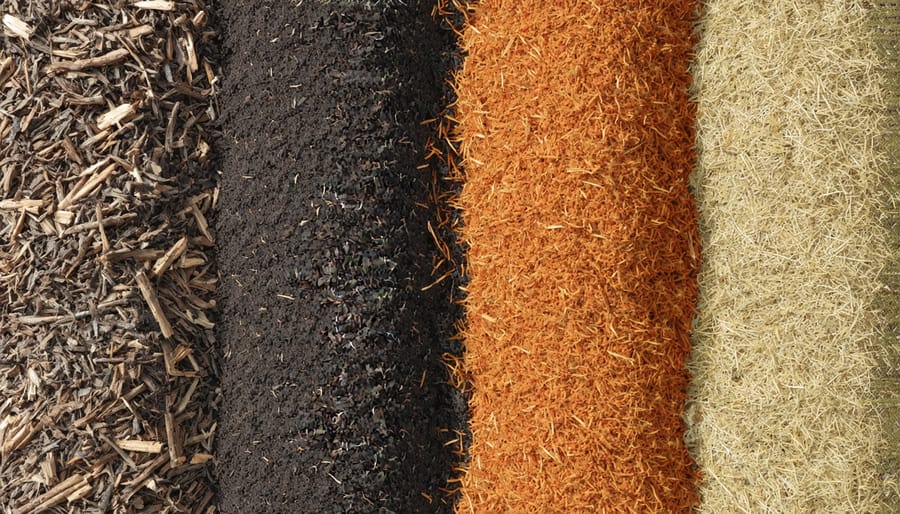
Local Mulch Sources
Alberta farmers have access to various locally-sourced mulch materials that align well with regenerative farming techniques. Straw from wheat, barley, and oat production remains the most readily available option, typically costing $5-8 per small square bale. This material provides excellent soil coverage and breaks down gradually over one to two growing seasons.
Wood chips and bark mulch from local sawmills and tree services offer another cost-effective solution, often available for bulk purchase at $25-35 per cubic metre. These materials are particularly effective for long-term erosion control due to their slower decomposition rate and ability to interlock on slopes.
Composted manure from Alberta’s livestock operations serves as an excellent mulch option, combining erosion control with soil enrichment. Many dairy and cattle operations offer this resource at competitive prices, typically $20-30 per tonne when purchased in bulk.
Green waste mulch, processed from municipal yard waste programs in Edmonton and Calgary, provides a sustainable option that supports local waste reduction efforts. This material is often available at community composting facilities for $15-25 per cubic metre.
For specialized applications, flax straw and canola residue from local processing facilities offer unique benefits, particularly their ability to form dense mats that effectively control erosion on steeper slopes.
Cost-Effective Choices
When comparing mulching options for erosion control in Alberta, straw remains one of the most cost-effective choices at approximately $2-3 per square metre when sourced locally. Wood chips, often available from municipal programs or local tree services, typically cost between $5-8 per square metre but offer longer-lasting protection.
For larger agricultural operations, investing in crop residue management can significantly reduce mulching expenses. Many Alberta farmers save $15-20 per acre annually by retaining and properly distributing crop residue instead of purchasing external mulching materials.
Prairie farmers have found success with innovative cost-saving approaches, such as establishing relationships with nearby landscaping companies for discounted wood mulch, or participating in municipal composting programs that offer free or low-cost organic materials. Some communities in central Alberta have established mulch-sharing networks, where farmers exchange different types of organic materials based on availability and needs.
While synthetic mulches like geotextiles have a higher initial cost of $12-15 per square metre, their multi-year durability often results in better long-term value. However, for most agricultural applications, natural mulches provide the best balance of cost and effectiveness, especially when considering their soil-enriching properties.
Remember to factor in application costs: mechanical spreading typically adds $1-2 per square metre, while manual application costs can reach $3-4 per square metre for larger areas.
Proven Mulching Techniques
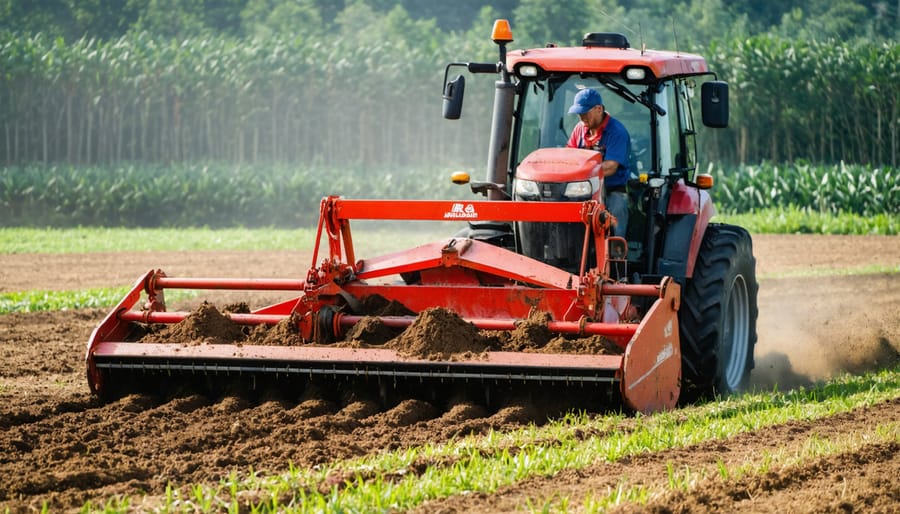
Application Methods
Proper application of mulch is crucial for effective erosion control in Alberta’s diverse agricultural landscape. Start by preparing your soil surface, ensuring it’s free from weeds and relatively smooth. For flat cropland, apply mulch evenly at a rate of 3-5 tonnes per hectare, maintaining approximately 80% ground coverage.
For sloped areas, increase coverage to 4-6 tonnes per hectare and consider these specific techniques:
On gentle slopes (up to 15%), spread mulch uniformly using a mechanical spreader, working from top to bottom. Anchor the mulch using a disk cultivator set straight, pressing it partially into the soil without burying it completely.
For steeper slopes (15-30%), use the crimping method. After spreading, use a mulch crimper to punch the material into the soil at 10-15 centimetre intervals. This creates vertical anchoring that better withstands water flow.
In high-wind areas common to southern Alberta, consider using tackifiers or netting to secure the mulch. Apply tackifier at a rate of 200-250 litres per hectare on a calm day to ensure even distribution.
For small-scale applications, hand-spreading is effective. Layer the mulch approximately 5-8 centimetres thick, ensuring you can still see about 20% of the soil through the coverage. This allows for proper water penetration while maintaining erosion control.
Remember to monitor mulch coverage after significant weather events and reapply as needed. In spring, assess winter damage and add fresh mulch to maintain adequate protection. For optimal results, combine mulching with other soil conservation practices like contour farming and cover cropping.
Timing and Maintenance
Proper timing and consistent maintenance are crucial for maximizing the effectiveness of mulch in controlling erosion. In Alberta’s climate, the ideal time to apply mulch is during late spring after the soil has warmed but before the summer heat sets in. This timing helps establish optimal soil moisture retention while protecting newly seeded areas.
Monitor your mulch depth regularly, maintaining a layer of 5-10 cm for most applications. In areas with steep slopes or high wind exposure, you may need to increase this to 15 cm. After heavy rains or strong winds, inspect the mulch coverage and redistribute or add material where needed.
For agricultural fields, plan to replenish organic mulch annually, typically after harvest and before winter sets in. This ensures adequate protection during spring thaw when erosion risk is highest. If using straw mulch, ensure it’s properly anchored using tackifiers or by incorporating it slightly into the soil surface.
Check for signs of decomposition in organic mulches and replace as needed. In general, woody mulches last longer than straw or leaf mulch, but all types require periodic assessment. Watch for signs of soil erosion beneath the mulch, such as small channels or bare patches, and address these promptly.
During the growing season, maintain a consistent mulch barrier around crops while allowing enough space around plant stems to prevent moisture-related issues. Consider rotating your mulch types between seasons to balance nutrient levels and prevent pest problems specific to certain materials.
Real Results: Alberta Success Stories
Before and After
Studies across Alberta farms show remarkable improvements after implementing proper mulching practices. On average, farms experienced a 60-75% reduction in soil loss during the first year of mulching implementation. A notable case study from Red Deer County demonstrated how a 160-hectare wheat field reduced soil erosion by 70% after applying straw mulch at 4 tonnes per hectare.
Local farmer James Morrison reported that his sloped fields, which previously lost up to 12 tonnes of topsoil per hectare annually, now maintain stable soil levels after three years of consistent mulching. His crop yield increased by 25% due to improved moisture retention and soil structure.
The University of Alberta’s Agricultural Research Station documented that mulched fields retained 40% more moisture compared to unmulched areas during dry periods. This translated to reduced irrigation needs and better crop resilience during drought conditions. Additionally, weed presence decreased by 65% in mulched areas, leading to reduced herbicide use.
Soil testing before and after mulching implementation showed significant improvements in organic matter content, increasing from an average of 2.5% to 4% over three years. The enhanced soil structure also improved water infiltration rates by 45%, reducing surface runoff during heavy rainfall events typical of Alberta summers.
These measurable improvements highlight mulching as a cost-effective solution for erosion control while providing additional benefits for soil health and crop productivity.
Lessons Learned
Through years of implementing mulching practices across Alberta’s diverse landscapes, farmers have gathered valuable insights worth sharing. The most successful erosion control outcomes consistently come from early implementation – don’t wait until erosion becomes visible to start mulching. Many experienced farmers emphasize the importance of proper mulch distribution, noting that uneven coverage can create new erosion patterns.
Weather monitoring has proven crucial for timing mulch applications. The best results are achieved when mulch is applied during relatively calm conditions, preventing wind from displacing materials before they can settle. Several farmers report that combining different mulch materials, such as straw with wood chips, provides better soil protection than single-material approaches.
Cost-effectiveness comes from sourcing local materials whenever possible. Many successful operations have established partnerships with nearby timber mills or landscaping companies for reliable mulch supplies. Regular monitoring and maintenance of mulched areas helps identify and address potential issues before they become problematic.
Perhaps the most important lesson is the value of patience. While some erosion control benefits are immediate, the full advantages of mulching – including improved soil structure and increased organic matter – develop over multiple growing seasons. Starting with small test areas has helped many farmers refine their techniques before implementing larger-scale mulching programs.
Remember that what works in southern Alberta may need adjustment for central or northern regions, so always consider your local conditions when planning your mulching strategy.
As we’ve explored throughout this guide, mulching stands as a proven, cost-effective solution for erosion control across Alberta’s diverse agricultural landscape. By implementing proper mulching techniques, you’re not just preventing soil erosion – you’re investing in your land’s long-term productivity and sustainability.
Remember that successful mulching starts with choosing the right materials for your specific needs, whether that’s straw for broad-acre crops, wood chips for windbreaks, or specialized biodegradable options for sensitive areas. Proper application timing and maintenance are equally crucial for maximizing erosion control benefits.
The success stories we’ve shared from fellow Alberta farmers demonstrate that mulching can reduce soil loss by up to 95% while improving soil moisture retention and organic matter content. These benefits extend beyond individual farms to strengthen our entire agricultural community’s resilience against erosion challenges.
Take the first step today by assessing your land’s erosion risk areas and developing a mulching strategy that works for your operation. Connect with your local agricultural extension office or conservation authority for additional guidance and potential cost-sharing programs.
Together, we can protect Alberta’s valuable topsoil for future generations while maintaining productive and profitable farming operations. The time and resources invested in mulching erosion control today will pay dividends in improved soil health and sustained crop yields for years to come.

